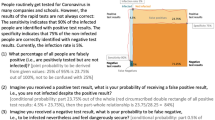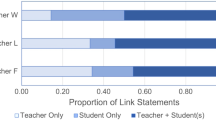Abstract
In this article, we present a coding framework based on simultaneity and connections. The coding focuses on microlevel attention to three aspects of simultaneity and connections: between representations, within examples, and between examples. Criteria for coding that we viewed as mathematically important within part-whole additive relations instruction were developed. Teachers’ use of multiple representations within an example, attention to part-whole relations within examples, and relations between multiple examples were identified, with teachers’ linking actions in speech or gestures pointing to connections between these. In this article, the coding framework is detailed and exemplified in the context of a structural approach to part-whole teaching in six South African grade 3 lessons. The coding framework enabled us to see fine-grained differences in teachers’ handling of part-whole relations related to simultaneity of, and connections between, representations and examples as well as within examples. We went on to explore the associations between the simultaneity and connections seen through the coding framework in sections of teaching and students’ responses on worksheets following each teaching section.









Similar content being viewed by others
References
Adler, J., & Venkat, H. (2014). Teachers’ mathematical discourse in instruction: Focus on examples and explanations. In H. Venkat, M. Rollnick, J. Loughran, & M. Askew (Eds.), Exploring content knowledge for teaching science and mathematics (pp. 132–146). London: Routledge.
Alibali, M. W., Nathan, M. J., Wolgram, M. S., Church, R. B., Jacobs, S. A., Martinez, C. J., & Knuth, E. J. (2013). How teachers link ideas in mathematics instruction using speech and gesture: A corpus analysis. Cognition and Instruction, 32(1), 65–100. London: Routledge.
Arzarello, F., Paola, D., Robutti, O., & Sabena, C. (2009). Gestures as semiotic resources in the mathematics classroom. Educational Studies in Mathematics, 70(2), 97–109.
Askew, M., Brown, M., Rhodes, V., Johnson, D. C., & Wiliam, D. (1997). Effective teachers of numeracy. Report of a study carried out for the Teacher Training Agency 1995–96 by the School of Education, King’s College London. London: Teacher Training Agency.
Carpenter, T. P., Fennema, E., Franke, M. L., Levi, L., & Empson, S. B. (1999). Children’s mathematics: Cognitively guided instruction. Portmouth, NH: Heinemann.
Clements, D. H. (1999). Playing math with young children. Curriculum Administrator, 35(4), 25–28.
Cobb, P., Boufi, A., McClain, K., & Whitenack, J. (1997). Reflective discourse and collective reflection. Journal for Research in Mathematics Education, 28(3), 258–277.
Doyle, W. (1983). Academic work. Review of Educational Research, 53, 159–199.
Flevares, L. M., & Perry, M. (2001). How many do you see? The use of nonspoken representations in first-grade mathematics lessons. Journal of Educational Psychology, 93, 330–345.
Fleisch, B. (2008). Primary education in crisis—Why South African schoolchildren underachieve in reading and mathematics. Cape Town: Juta & Co.
Hiebert, J., Gallimore, R., Garnier, H., Givvin, K. B., Hollingsworth, H., Jacobs, J., et al. (2003). Teaching mathematics in seven countries: Results from the TIMSS 1999 video study (NCES 2003–013). U.S. Department of Education. Washington, DC: National Center for Education Statistics.
Kullberg, A., Runesson, U., & Mårtensson, P. (2014). Different possibilities to learn from the same task. PNA, 8(4), 139–150.
Lesh, R., Post, T., & Behr, M. (1987). Representations and translations among representations in mathematics learning and problem solving. In C. Janvier (Ed.), Problems of representation in teaching and learning of mathematics (pp. 33–40). Hilldale, NJ: Erlbaum.
McNeill, D. (1992). Hand and mind: What gesture reveals about thought. Chicago, IL: University of Chicago Press.
Marton, F., & Booth, S. (1997). Learning and awareness. Mahwah, NJ: Erlbaum.
Marton, F. (2015). Necessary condition of learning. London: Routledge.
Marton, F., Runesson, U., & Tsui, A. B. (2004). The space of learning. In F. Marton & A. B. Tsui (Eds.), Classroom discourse and the space of learning (pp. 3–40). Mahwah, N.J: Erlbaum.
Marton, F., & Pang, M. F. (2006). On some necessary conditions for learning. The Journal of the Learning Sciences, 15(2), 193–220.
Mason, J., Stephens, M., & Watson, A. (2009). Appreciating mathematical structure for all. Mathematics Education Research Journal, 21(2), 10–32.
Neuman, D. (1987). The origin of arithmetic skills. A phenomenographic approach. Göteborg: Acta Universitatis Gothoburgensis.
Neuman, D. (1999). Early learning and awareness of division: A phenomenographic approach. Educational Studies in Mathematics, 40, 101–128.
Neuman, D. (2013). Att ändra arbetssätt och kultur inom den inledande aritmetikundervisningen [Changing approach and culture within the introduction of arithmetic; in Swedish]. Nordic Studies in Mathematics Education, 18(2), 3–46.
Rowland, T. (2008). The purpose, design, and use of examples in teaching of elementary mathematics. Educational Studies in Mathematics, 69, 143–163.
Sun, X. (2011). ‘Variation problems’ and their roles in the topic of fraction division in Chinese mathematics textbook examples. Educational Studies in Mathematics, 76, 65–85.
Sandefur, J., Mason, J., Stylianides, G. J., & Watson, A. (2013). Generating and using examples in the proving process. Educational Studies in Mathematics, 83, 323–340.
Schmittau, J. (2004). Vygotskian theory and mathematics education: Resolving the conceptual-procedural dichotomy. European Journal of Psychology of Education, 19(1), 19–43.
Schollar, E. (2008). Final Report: The primary mathematics research project 2004–2007—Towards evidence-based educational development in South Africa. Johannesburg: Eric Schollar & Associates.
Venkat, H., & Adler, J. (2012). Coherence and connections in teachers’ mathematical discourses in instruction. Pythagoras, 33(3), 25–32.
Venkat, H., & Naidoo, D. (2012). Analyzing coherence for conceptual learning in a grade 2 numeracy lesson. Education as Change, 16(1), 21–33.
Venkat, H., Ekdahl, A-L., & Runesson, U. (2014). Connections and simultaneity: Analysing South African G3 Part-part-whole teaching. In C. Nicol, S. Oesterle, P. Liljedahl, & D. Allan (Eds.), Proceedings of the Joint Meeting of PME 38 and PME-NA 36 (Vol. 5, pp. 337–344). Vancouver, Canada: PME.
Watson, A., & Mason, J. (2006a). Seeing an exercise as a single mathematical object: Using variation to structure sense-making. Mathematical Thinking and Learning, 8(2), 91–111.
Watson, A., & Mason, J. (2006b). Variation and mathematical structure. Mathematics Teaching, 194, 3–5.
Acknowledgments
This paper forms part of the work in progress within the Wits SA Numeracy Chair project, entitled the Wits Maths Connect—Primary project. It is generously funded by the FirstRand Foundation, Anglo American, Rand Merchant Bank, and the Department of Science and Technology and is administered by the National Research Foundation.
Author information
Authors and Affiliations
Corresponding author
Additional information
Preliminary analysis was presented in Venkat, Ekdahl & Runesson (2014) at the PME 38 and PME-NA 36 conference in Vancouver, Canada.
Rights and permissions
About this article
Cite this article
Ekdahl, AL., Venkat, H. & Runesson, U. Coding teaching for simultaneity and connections. Educ Stud Math 93, 293–313 (2016). https://doi.org/10.1007/s10649-016-9700-0
Published:
Issue Date:
DOI: https://doi.org/10.1007/s10649-016-9700-0




